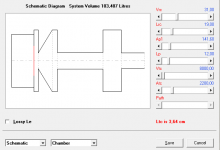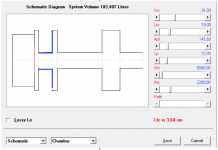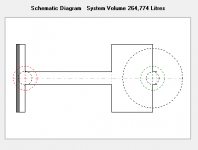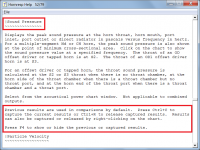the responses are very similar up to about 1000 hertz
On closer inspection - they are similar up to about 800 hertz.
VERDICT - It seems that you can use either model, but my original "gut feeling" bass reflex choice gives a slightly nicer-looking response at the higher frequencies 🙂
The models have different net volumes. The TH model is likely more accurate in this case.
Originally Posted by mwmkravchenko
Lot's of those masquerading as tapped horn
Yes there are !
@ turk 182
Re Driver Polarity
Well, i would have expected that this would matter.
1 - Otherwise the TH's would be opposite polarity to the mains
2 - Also affecting the Xover point & phase etc.
Originally Posted by mwmkravchenko
You get a nice big peak in output right around kick drum 110 to 130 hertz.
Sure, BUT, that's no use as a Real BASS cab.
Originally Posted by David McBean
My curiosity got the better of me
Good 😉 Thanx for the sims 🙂 I'll have a tinker with a more suitable driver & volume.
Originally Posted by Brian Steele
The models have different net volumes
Yes they do
without knowing crossover points or DSP eq used it's still conjecture on our part, but i vote tapped horn...and i'll buy a scotch for whomever sides with me....
Hi,
Since stepped segment is alredy implemented... ^^
Should it be possible to make AP1 stepped too , from front chamber enclosure to it next jonction ?
So it would be possible to do as second picture, whereas actually it does as first one.
(However it should be called ^^ )
THANKS !
damien
Since stepped segment is alredy implemented... ^^
Should it be possible to make AP1 stepped too , from front chamber enclosure to it next jonction ?
So it would be possible to do as second picture, whereas actually it does as first one.
(However it should be called ^^ )
THANKS !
damien
Attachments
The models have different net volumes. The TH model is likely more accurate in this case.
TH FTW! BR's and TH's require 7 boards minimum. Would you rather your 7th board create a port or a HORN???
Last edited:
The models have different net volumes. The TH model is likely more accurate in this case.
Hi Brian,
Just to clarify - are you saying that the tapped horn model, which predicts a more "ragged" upper frequency response, is likely to be more accurate because the volume (31 litres) is less than that of the modified bass reflex model (39.5 litres), or because you consider the actual Pioneer loudspeaker to operate more as a tapped horn than as a bass reflex system?
(The difference in volume is due to the addition of segment 4 (8.5 litres) in the modified bass reflex system, to provide the appropriate loading on the direct radiator).
Kind regards,
David
Should it be possible to make AP1 stepped too , from front chamber enclosure to it next jonction ?
Hi Damien,
Assuming it can be done, the "stepped" throat adaptor could only be cylindrical, as shown in Attachment 1. It could not be flared as shown in Attachment 2. Would this be sufficient?
Kind regards,
David
Attachments
Hi David,Hi Damien,
Assuming it can be done, the "stepped" throat adaptor could only be cylindrical, as shown in Attachment 1. It could not be flared as shown in Attachment 2. Would this be sufficient?
Kind regards,
David
I was thinking about using a round PVC pipe as a throat adapter just the other day to ensure even loading of the driver.

Hi Damien,
Assuming it can be done, the "stepped" throat adaptor could only be cylindrical, as shown in Attachment 1. It could not be flared as shown in Attachment 2. Would this be sufficient?
Kind regards,
David
Hi,
It would be really awesome, allowing to get another segment !
Thanks !
Just to clarify - are you saying that the tapped horn model, which predicts a more "ragged" upper frequency response, is likely to be more accurate because the volume (31 litres) is less than that of the modified bass reflex model (39.5 litres), or because you consider the actual Pioneer loudspeaker to operate more as a tapped horn than as a bass reflex system?
The way both sims are laid out, it looks like the net volume of the TH sim will be closer to the actual net volume than the net volume of the BR sim.
Lol...yes, but more in the way of a port, using stepped segment as in post 5741478 figure 2 : back + front chamber + AP1 + 4 stepped segment = 7 segments. Ok it's a closed back example, but it should work with TH (as i suspect you may want to). And those special extra segment from use of back/front/port near the speaker, cannot be stuffed, the way it is now 🙄Did someone say "another segment" ?
🙂
And speaker keep in TH connected to S2 and not S1 so L12 is a intermediate chamber that can be stuffed and tuned when using back/front chambers/port. It's a really interesting feature.
Last edited:
Interesting! Can you show us an example of a 7 segment TH input and diagram screens?
Not really a TH since segments are stepped to increase bandpass effect. Red is with L12=0 to show massive effect of this small intermediate damping chamber. Something called sometime "stub" ^^
EDIT : Found ! In fact, i already played around this here en 2015 :
4 octave Tapped Horn Variant (hornresp sim in ^^)
Attachments
Last edited:
Hello David,
I just encountered something:
When comparing pressures on a TH design (both mouth and tapped throat) from one design to another, hornresp seems to memorize the last pressure calculation, not the two separately. So enabling "compare" always gives the previous calculated pressure, not the one from the previous design.
Would it be a good idea to have internal memory for both the pressure calcs?
While I am thinking - it could come in handy to have a mode where all the calculations possible are done in one click - and after hitting "capture these results" were memorized.
E.g. "impulse" requires no further input (unlike directivity), so it could be calculated automatically. Now it is s only available to compare to another design after being calculated once.
I am aware this might take some computing time, but PCs nowadays are very fast - I wouldn´t mind 🙂
Just some thoughts 🙂
As always, thank you so much for this wonderful peace of software!
I just encountered something:
When comparing pressures on a TH design (both mouth and tapped throat) from one design to another, hornresp seems to memorize the last pressure calculation, not the two separately. So enabling "compare" always gives the previous calculated pressure, not the one from the previous design.
Would it be a good idea to have internal memory for both the pressure calcs?
While I am thinking - it could come in handy to have a mode where all the calculations possible are done in one click - and after hitting "capture these results" were memorized.
E.g. "impulse" requires no further input (unlike directivity), so it could be calculated automatically. Now it is s only available to compare to another design after being calculated once.
I am aware this might take some computing time, but PCs nowadays are very fast - I wouldn´t mind 🙂
Just some thoughts 🙂
As always, thank you so much for this wonderful peace of software!
The way both sims are laid out, it looks like the net volume of the TH sim will be closer to the actual net volume than the net volume of the BR sim.
Thanks for the clarification.
Hi Sabbelbacke,
When the first sound pressure chart is displayed, press Ctrl+C or right-click to capture the current results. See the Help file for further details.
Results that take a significant amount of time to calculate, or that require additional input values to be specified, are calculated on demand only. All other results (including sound pressure) are calculated when the Calculate button is pressed. Having the option of a different mode of operation would complicate things greatly. It's not going to happen 🙂.
Kind regards,
David
So enabling "compare" always gives the previous calculated pressure, not the one from the previous design.
When the first sound pressure chart is displayed, press Ctrl+C or right-click to capture the current results. See the Help file for further details.
it could come in handy to have a mode where all the calculations possible are done in one click
Results that take a significant amount of time to calculate, or that require additional input values to be specified, are calculated on demand only. All other results (including sound pressure) are calculated when the Calculate button is pressed. Having the option of a different mode of operation would complicate things greatly. It's not going to happen 🙂.
Kind regards,
David
Attachments
Not really a TH since segments are stepped to increase bandpass effect. Red is with L12=0 to show massive effect of this small intermediate damping chamber. Something called sometime "stub" ^^
EDIT : Found ! In fact, i already played around this here en 2015 :
4 octave Tapped Horn Variant (hornresp sim in ^^)
Wow! I counted 7 segments! Nice job!
David,
I Would like express you appreciation and Big Thanks for hornresp program you are developing. Great thing 😎 and it is quite popular in Russia and Ukraine. At least I registered here to say these words to you, but now when started my first project with transmission line several questions appeared. I just try to find answers at my own but got feeling some time after I will raise hands up and seek for help 😀
I Would like express you appreciation and Big Thanks for hornresp program you are developing. Great thing 😎 and it is quite popular in Russia and Ukraine. At least I registered here to say these words to you, but now when started my first project with transmission line several questions appeared. I just try to find answers at my own but got feeling some time after I will raise hands up and seek for help 😀
- Home
- Loudspeakers
- Subwoofers
- Hornresp






